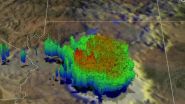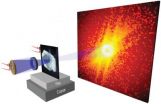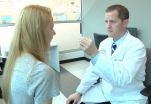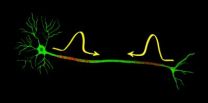(Press-News.org) University of Pennsylvania researchers have made another advance in understanding how the brain detects errors caused by unexpected sensory events. This type of error detection is what allows the brain to learn from its mistakes, which is critical for improving fine motor control.
Their previous work explained how the brain can distinguish true error signals from noise; their new findings show how it can tell the difference between errors of different magnitudes. Fine-tuning a tennis serve, for example, requires that the brain distinguish whether it needs to make a minor correction if the ball barely misses the target or a much bigger correction if it is way off.
The study was led by Javier Medina, an assistant professor in the Department of Psychology in Penn's School of Arts & Sciences, and Farzaneh Najafi, then a graduate student in the Department of Biology. They collaborated with postdoctoral fellow Andrea Giovannucci and associate professor Samuel S. H. Wang of Princeton University.
It was published in the journal eLife.
Our movements are controlled by neurons known as Purkinje cells. Each muscle receives instructions from a dedicated set of hundreds of these brain cells. The instructions sent by each set of Purkinje cells are constantly fine tuned by climbing fibers, a specialized group of neurons that alert Purkinje cells whenever an unexpected stimulus occurs.
"An unexpected stimulus is often a sign that something has gone wrong," Medina said, "When this happens, climbing fibers send signals to their related Purkinje cells that an error has occurred. These Purkinje cells can then make changes to avoid the error in the future."
These error signals are mixed in with random firings of the climbing fibers, however, and researchers were long mystified about how the brain tells the difference between this noise and the useful, error-related information it needs to improve motor control.
Medina and his team showed the mechanism behind this differentiation in a study published earlier this year. By using a non-invasive microscopy technique that could monitor the Purkinje cells of awake and active mice, the researchers could measure the level of calcium within these cells when they received signals from climbing fibers.
The unexpected stimuli in this experiment were random puffs of air to the face, which caused the mice to blink. The researchers located Purkinje cells that control the mice's eyelids and saw that calcium levels necessary for neuroplasticity, i.e., the brain's ability to learn, were greater when the mice got an error signal triggered by a puff of air than they were after a random signal.
While being able to make such a distinction is critical to the brain's ability to improve motor control, more information is needed to fine-tune it.
"We wanted to see if the Purkinje cells could tell the difference not just between random firings and true errors signals but between smaller and bigger errors," Medina said.
In their new study, the researchers used the same experimental set-up, with one key difference. They used air puffs of different durations: 15 milliseconds and 30 milliseconds.
What they found was that the eyelid-associated Purkinje cells filled with different amounts of calcium depending on the length of the puff; the longer ones produced larger spikes in calcium levels.
In addition, the researchers saw that different percentages of eyelid-related Purkinje cells respond depending on the length of the puff.
"Though there is a large population of climbing fibers that can give error-related information to the relevant Purkinje cells when they encounter something unexpected, not all of them fire each time," Medina said. "We saw that there is information coded in the number of climbing fibers that fire. The longer puffs corresponded to more climbing fibers sending signals to their Purkinje cells."
Their study could help explain how practice makes perfect, even when errors are imperceptibly small.
"If you felt a short puff and a long puff, you might not be able to say which one was which, but Purkinje cells can tell the difference," Medina said. "The difference between a 'very good' and an 'awesome' tennis serve rests on being able to distinguish errors even as tiny as that."
INFORMATION:
The research was supported by the National Institutes of Health, Searle Scholars Program, New Jersey Commission on Brain Injury Research and W. M. Keck Foundation.
Penn research shows how brain can tell magnitude of errors
2014-09-10
ELSE PRESS RELEASES FROM THIS DATE:
Ocean warming affecting Florida reefs
2014-09-10
ST. PETERSBURG, Fla.— Late-summer water temperatures near the Florida Keys were warmer by nearly 2 degrees Fahrenheit in the last several decades compared to a century earlier, according to a new study by the U.S. Geological Survey.
Researchers indicate that the warmer water temperatures are stressing corals and increasing the number of bleaching events, where corals become white resulting from a loss of their symbiotic algae. The corals can starve to death if the condition is prolonged.
"Our analysis shows that corals in the study areas are now regularly experiencing ...
Networking can make some feel 'dirty,' says new study
2014-09-10
Toronto – If schmoozing for work leaves you with a certain "ick" factor, that's not just awkwardness you're feeling.
Professional networking can create feelings of moral impurity and physical dirtiness, shows a new study.
That can hold people back from networking more, reducing career opportunities and lowering job performance, says study co-author Tiziana Casciaro, an associate professor of organizational behaviour and human resource management at the University of Toronto's Rotman School of Management. The study was co-written with fellow researchers Prof. Francesca ...
New evidence points to outcomes and cost benefits of telemedicine
2014-09-10
New Rochelle, NY, September 10, 2014—Congestive heart failure, stroke, and chronic obstructive pulmonary disease (COPD) are three of the leading causes of death in the U.S. The use of telemedicine to help manage chronic diseases such as these can yield clear benefits including fewer and shorter hospital stays, fewer emergency room visits, less severe illness, and even fewer deaths, as reported in a study published in Telemedicine and e-Health, a peer-reviewed journal from Mary Ann Liebert, Inc., publishers. The article is available free on the Telemedicine and e-Health ...
Halving the risk of preterm birth for some twin pregnancies
2014-09-10
International research involving the University of Adelaide has found that the risk of preterm birth could be halved for a specific group of "super high-risk" twin pregnancies.
The results could help to save babies' lives throughout the world and prevent serious health complications after birth.
The study, involving researchers from the University of Adelaide's Robinson Research Institute, reviewed all of the previous large studies conducted into the use of progestogen hormones, which have been trialed over the past 10 years to help prevent preterm birth in twins. ...
NASA tracks Norbert moisture to Arizona's drenching thunderstorms
2014-09-10
VIDEO:
This simulated flyby of NASA's TRMM satellite on Sept. 8 saw rain falling at a rate of over 62 mm (2.4 inches) per hour in some downpours over Arizona. Some...
Click here for more information.
Post-tropical storm Norbert may have been centered a couple of hundred miles off the northwestern coast of Mexico's Baja California, but the flow of warm, moist air that spun around it generated drenching thunderstorms over Arizona. NASA's TRMM satellite saw Norbert's remnants and ...
Where to grab space debris
2014-09-10
Objects in space tend to spin — and spin in a way that's totally different from the way they spin on earth. Understanding how objects are spinning, where their centers of mass are, and how their mass is distributed is crucial to any number of actual or potential space missions, from cleaning up debris in the geosynchronous orbit favored by communications satellites to landing a demolition crew on a comet.
In a forthcoming issue of the Journal of Field Robotics, MIT researchers will describe a new algorithm for gauging the rotation of objects in zero gravity using only ...
Advanced light source sets microscopy record
2014-09-10
A record-setting X-ray microscopy experiment may have ushered in a new era for nanoscale imaging. Working at the U.S. Department of Energy (DOE)'s Lawrence Berkeley National Laboratory (Berkeley Lab), a collaboration of researchers used low energy or "soft" X-rays to image structures only five nanometers in size. This resolution, obtained at Berkeley Lab's Advanced Light Source (ALS), a DOE Office of Science User Facility, is the highest ever achieved with X-ray microscopy.
Using ptychography, a coherent diffractive imaging technique based on high-performance scanning ...
Missing piece found to help solve concussion puzzle
2014-09-10
PITTSBURGH, Sept. 10, 2014 – Researchers at UPMC and the University of Pittsburgh have created a new, 5- to 10-minute test that could be added to a clinician's concussion evaluation toolkit for a more comprehensive assessment of the injury.
In a recent study published online first by the American Journal of Sports Medicine, researchers from the UPMC Sports Medicine Concussion Program demonstrated that clinicians could use their novel Vestibular/Ocular Motor Screening (VOMS) examination to be 90 percent accurate in identifying patients with concussion. The VOMS, which ...
Nerve impulses can collide and continue unaffected
2014-09-10
According to the traditional theory of nerves, two nerve impulses sent from opposite ends of a nerve annihilate when they collide. New research from the Niels Bohr Institute now shows that two colliding nerve impulses simply pass through each other and continue unaffected. This supports the theory that nerves function as sound pulses. The results are published in the scientific journal Physical Review X.
Nerve signals control the communication between the billions of cells in an organism and enable them to work together in neural networks. But how do nerve signals work? ...
Non-dominant hand vital to the evolution of the thumb
2014-09-10
New research from biological anthropologists at the University of Kent has shown that the use of the non-dominant hand was likely to have played a vital role in the evolution of modern human hand morphology.
In the largest experiment ever undertaken into the manipulative pressures experienced by the hand during stone tool production, researchers analysed the manipulative forces and frequency of use experienced by the thumb and fingers on the non-dominant hand during a series of stone tool production sequences that replicated early tool forms.
It is well known that ...







